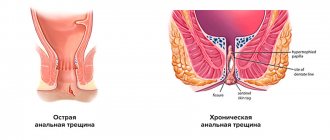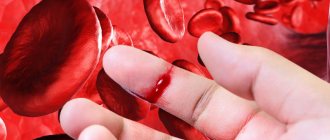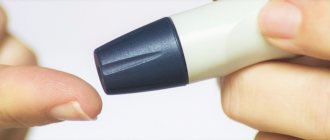Causes of bleeding from the anus
If you notice blood on toilet paper after bowel movements, even if the process of bowel movement occurs without pain, you should definitely consult a proctologist for advice in order to establish the cause of the bleeding, start treatment in a timely manner and avoid possible complications.
Why does blood appear from the anus after stool in both men and women:
- A fairly common factor is hemorrhoids (enlargement of the veins of the rectum). Scarlet blood appears from the anus during defecation.
- Anal fissure is the second most common cause of rectal bleeding. The disease is characterized by a burning sensation during bowel movements, sometimes accompanied by acute pain (patients describe it as cutting and then squeezing). Bloody discharge appears in both small and copious portions.
- Inflammatory diseases of the colon.
- The presence of benign formations (polyps). A characteristic symptom is the discharge of blood from the rectum after defecation. The blood is darker, often with mucus.
- The presence of a malignant tumor of the rectum. Blood of different colors may be released. Quite often, the blood released does not differ in any way from the blood that is released, for example, from hemorrhoidal tissue. And if the presence of hemorrhoidal disease only worsens the quality of life (hemorrhoidal tissue never degenerates into a malignant tumor), then the presence of a benign formation or a malignant tumor can be harmful to health and life-threatening, which is why you should not try to independently determine the source.
Only a coloproctologist can determine the true cause of bleeding from the anus and select the appropriate treatment. Timely diagnosis allows for effective conservative and minimally invasive treatment.
Does blood in stool depend on menstruation?
There are times when bloody mucus may be released during bowel movements the day before or during menstruation. There are several reasons that contribute to this situation:
What does a stool occult blood test show?
- The result of aggravated hemorrhoids (blood comes out along with feces). The disease can acutely manifest itself two days before the onset of menstruation. The approach of a new period of menstruation provokes an increase in the activity of blood flow to the pelvic area. In such a case, the hemorrhoidal node becomes inflamed and when visiting the toilet you can see blood in the stool.
- Endometriosis is a pathological process in which endometrial cells spread to neighboring organs of the female body. The disease can develop as a result of disturbances in the level of steroid hormones and immunological status. Despite the fact that the cells are located in neighboring organs, they continue to perform their functional duties. In cases where the endometrium has settled in the rectal area, you can expect bloody discharge in the stool during menstruation. In this case, women often experience blood in their stool.
Discharge color and disease
- bright red, scarlet blood from the anus on toilet paper or underwear, drops at the end of a bowel movement (stool) - hemorrhoids or anal fissure;
- red color of blood during anal bleeding - cancerous tumor, intestinal polyp;
- dark blood clots - tumors of the distal colon, diverticulosis;
- cherry-colored blood from the anus - pathology of the colon;
- black, tarry stools - diseases of the stomach, duodenum and small intestine.
IMPORTANT!
Bleeding is a serious symptom, after the appearance of which you cannot postpone a visit to the doctor. Unfortunately, blood from the anus can cause diseases such as a tumor of the rectum or colon. And in the worst case, this tumor may turn out to be malignant. Blood can also occur as a result of injury to a polyp - a benign tumor. Long-term polyposis can be a sign of colon cancer.
Helminthiasis
Infection with helminths is another possible cause of light bleeding from the anus. Signs of helminthic infestation may be mild, so you must be attentive to any existing symptoms. It can be:
- itching in the anus;
- redness of the skin of the anus and genitals;
- weight loss;
- constant headaches.
When infected with worms, the patient loses his appetite, he develops signs of general intoxication: drowsiness, lethargy, decreased performance. The temperature may remain within normal limits or rise to low-grade fever. A rise above 38° rarely occurs - only in the case of extensive damage to internal organs by mixed forms of parasitic infections.
Bleeding from helminthiasis is not profuse and not painful. Blood may cover or be mixed with the stool.
Treatment of helminthic infestation
To destroy worms in adults and children, anthelmintic drugs based on levamisole or mebendazole are used: “ Dekaris
", "
Vermox
", "
Pyrantel
". "Pyrantel" in most cases is the drug of choice, as it can be used for the treatment of mixed helminthic infestations. Children can be given the product in the form of a sweet suspension (5-10 ml once). For adults, the drug is available in the form of tablets, which must be chewed thoroughly with a sufficient amount of water. The dosage for adults is 3 tablets. If the patient's weight exceeds 75 kg, the dose is increased to 4 tablets.
The drug is taken once after a meal. To exclude self-infection and prevent secondary infection, the medication must be taken again after 3 weeks.
Bleeding pattern and disease
- Regular heavy bleeding not associated with bowel movements - diverticulosis, polyposis, Crohn's disease, ulcerative colitis, rectal or colon cancer;
- Blood mixed with feces - cancer of the rectum and colon;
- Bleeding with diarrhea - dysbiosis, irritable bowel syndrome;
- Discharge of blood with mucus or pus - internal hemorrhoids, rectal prolapse or polyp;
- Severe bleeding with mucus - proctitis, colitis, rectal cancer.
Make an appointment
Preventive measures
To avoid the appearance of bloody discharge in stool, basic preventive measures should be followed:
- Include foods that contain sufficient fiber in your daily diet. By eating cereals, vegetable dishes and fresh fruits, you can get rid of constipation and forget about anal bleeding.
- Drink at least 2 liters of clean water and freshly squeezed juices daily. Drinking plum juice will help prevent constipation.
- Timely bowel movements.
- Systematic performance of Kegel exercises.
The appearance of bloody clots in the stool should be a cause for concern. A timely visit to a doctor helps to cure most ailments quickly and without surgical interventions.
Diagnosis and treatment
When faced with an intimate problem, especially such as bleeding from the anus during bowel movements, you can get confused, especially if you don’t know about the methods of diagnosing and treating such ailments or don’t understand which doctor to contact.
A proctologist or coloproctologist is a doctor who diagnoses and treats diseases of the colon, rectum and anus, as well as problems of the sacrum, coccyx and perineum. You should not postpone a visit to this specialist if there is blood from the anus after stool.
A proctologist will listen to complaints and the history of their occurrence, and to determine the cause of the appearance of blood from the rectum, he may perform the following procedures:
Digital examination of the rectum: a primary research method that makes it possible to assess the condition of the anus and identify possible pathologies in the form of neoplasms, anal fissures, uncharacteristic discharge, and bleeding.
After a digital examination, the coloproctologist, if necessary, prescribes further diagnostic methods using special equipment:
- Anoscopy. This is an examination of the last 3-7 cm of the rectum; it is in this area that almost half of the sources of visible bleeding are located. There are several types of anoscopes (straight, conical, with and without a cutout, transparent and not transparent), each of them is used strictly according to indications, but any of these types allows you to perform a full examination of the anal canal and lower ampullary rectum. Anoscopy is used when performing minimally invasive methods of treating hemorrhoids (ligation, sclerotherapy), as well as performing a number of surgical interventions (bipolar coagulation). As a rule, no preparation is required to perform diagnostic anoscopy; preparation is required for anoscopy for therapeutic purposes.
- Sigmoidoscopy or rectoscopy (RRS or RRS) is a diagnostic procedure using a special device with a camera. It makes it possible at the initial appointment to quickly and painlessly visually assess the condition of the rectal mucosa, identify the presence of mucosal formations and compression of the intestine. During rectoscopy, up to 20 cm of the intestine is examined (the entire rectum and the place of its transition to the sigmoid). Preparation is required for rectoscopy.
- Colonoscopy is the most informative method of examining the large intestine compared to others. It is carried out using a flexible fiber colonoscope equipped with a high-resolution camera that will show even the smallest sources of bleeding. The procedure is also prescribed for the purpose of endoscopic removal of colon formations. A colonoscopy is performed by an endoscopist.
The appropriate method of treating the disease is determined and prescribed by the doctor. You should not engage in self-treatment and neglect contacting a coloproctologist.
General picture of the problem
If blood drips from the anus from time to time, regardless of whether women or men have a similar problem, you should undergo a full examination to identify the causes. Diagnosis is fundamentally important, since red or dark blood with clots does not flow against the background of harmless causes.
At the first stages, such discharge may not cause serious concern; it appears from time to time and disappears immediately after defecation.
If no therapeutic action is taken, then rare discharges of blood after bowel movements become more frequent, occur after almost every visit to the toilet, and are complemented by complicated pathological symptoms.
Based on the nature of the bleeding and accompanying symptoms, the doctor will be able to make a preliminary diagnosis and suggest its causes, though. According to statistics, the most common cause of the problem is hemorrhoids.
Inflammation of the pancreas (pancreatitis) is a serious disease accompanied by acute pain and various disorders of the gastrointestinal tract. Read more in the article: “quick treatment of the pancreas with folk remedies.”
How to prepare for the examination?
The own research of specialists from the proctology department of the Altermed clinic made it possible to make a visit to a proctologist as easy and comfortable as possible. There is no longer any need to fast the day before and plan the procedure for the morning. In the proctology departments of Altermed, a way has been found to successfully cope with all these difficulties. This is Microlax bowel preparation.
The use of Microlax microenemas makes fasting unnecessary, does not require special equipment or premises, and saves a lot of time. The laxative effect occurs 5-15 minutes after administration of the drug. The quality of bowel cleansing is such that treatment can begin immediately after rectoscopy and anoscopy. If it is necessary to use during pregnancy and lactation, Microlax does not require special precautions.
The Proctology Clinic provides diagnostics using the most modern equipment. The best doctors in St. Petersburg - both men and women - and a delicate approach are at your service.
Crohn's disease
Crohn's disease is a severe inflammatory disease of all layers of the intestinal wall. In this case, nodules called granulomas appear inside the intestinal wall. The disease cannot be completely cured, only achieving remission. Crohn's disease affects all parts of the gastrointestinal tract. The mucous membrane becomes covered with ulcerative lesions, the ulcers can deepen, pseudopolyps are formed, polyps and ulcers alternate with each other. When the disease becomes more complicated, fever, bleeding, abscesses, fistulas, and peritonitis appear. Characterized by abdominal pain, flatulence, weight loss, anemia, hypovitaminosis. The disease develops slowly over several years. With Crohn's disease, symptoms such as damage to the joints, the mucous membrane of the eyes, and inflammation of the lymph nodes appear.
Factors that influence the development of the disease
What factors influence the opening of bleeding in hemorrhoids? The following provoking factors are identified:
- regular anal sex;
- excessive physical activity, standing work, heavy lifting;
- playing sports, as intra-abdominal pressure increases sharply;
- menopause in women;
- problems with bowel movements during pregnancy;
- hormonal changes;
- attempts during labor;
- chronic constipation or diarrhea;
- infectious bowel disease;
- lack of enzymes;
- increased bleeding of blood vessels;
- deficiency of vitamins and minerals;
- liver cirrhosis and secondary hemorrhoids;
- presence of anal fissures;
Reduced immunity may also be a factor.
ethnoscience
Traditional medicine is used in combination with traditional methods of treatment. Folk remedies are effective in maintaining personal hygiene and relieving inflammatory syndrome. Bleeding is almost impossible to stop with the help of medicinal herbs. It is recommended to carry out sitz baths twice a day, make microenemas from oak bark, calendula, chamomile, yarrow, and blueberries. Inflammation is also relieved with suppositories made from propolis, fir and sea buckthorn oil.
It is imperative to stop drinking alcohol, smoking, and lifting heavy objects. Include sports, exercise, and moderate physical activity in your daily routine. Eliminate fried and smoked foods, strong coffee, and animal fats from your diet. Add fruits and vegetables, berries, cereals and broths, and boiled meat to the menu. Drink at least one and a half liters of water a day.
Bleeding from hemorrhoids
Anal hemorrhoidal bleeding is varicose veins of the rectum, often accompanied by the formation of blood clots and the appearance of hemorrhoids. It occurs when the venous outflow from the intestine is disrupted: the veins dilate, blood accumulates in the dilated areas, thickens, and nodes appear. This makes it difficult for stool to pass through the rectum and often causes bleeding. Causes of pathology:
Advertising:
- Frequent constipation
. Due to the prolonged presence of feces in the intestines, it becomes excessively hard, and this can injure the delicate mucous membrane. If the damage is significant, it does not have time to heal, and each act of defecation leads to more significant injuries. Therefore, bleeding may increase over time. - Straining with constipation
. This increases pressure on the pelvic area. Diarrhea. With diarrhea, there is irritation of the anal mucosa and its depletion, which can also provoke bleeding. - Stagnation of blood in the pelvic and rectal areas
. This causes weakening and thinning of the vascular wall and the formation of various defects in it: small erosions, ulcers and cracks, which are aggravated when feces pass through the anus. - The presence of hemorrhoids, especially untreated
: cones fall out, hygiene rules are difficult to follow, infection may occur with inflammation of the nodes and bleeding.
Is rectal bleeding a reason to panic?
Advertising:
Despite the fact that there are no minor reasons that could provoke such a phenomenon, situations can still be different. Sometimes you can wait a few hours before the start of a new working day and go to see a doctor as usual, but sometimes the situation is urgent: you should call a doctor and often agree to hospitalization. Such situations are the following:
- Copious bleeding that cannot be stopped;
- Vomiting, with contents in which traces of blood are visible;
- Bloody discharge from the nasal passages;
- Detection of hematomas, bruises, the nature of which is not mechanical (bruise, blow, etc.);
- General deterioration in health: increased body temperature, abdominal pain.
If, after visiting the toilet, you find traces of blood on the paper, and one of the listed conditions is present, call an ambulance immediately. The appearance of rectal bleeding does not always mean an advanced disease. For example, with tumors of the digestive organs, it is the first symptom, but the color and amount of discharge will depend on the location of the tumor. It is also possible to detect blood almost immediately with intestinal diverticulosis, since this disease is characterized by protrusion of the walls.










